The railway between Altrincham and Chester was opened in stages between 1869 and 1874. The section between Altrincham and Northwich, which was promoted by the Cheshire Midland Railway, opened in 1863. The line from Northwich to Helsby was constructed by the West Cheshire Railway company, but before the line was completed it, along with the Cheshire Midland Railway, became part of the Cheshire Lines Committee (CLC) in 1866. The CLC remained a separate railway company until 1948 when it was nationalised and became part of British Railways.

Northwich station plan 1867. This is probably one of the earliest railway plans of the station area. The new re-sited station, now shown positioned on the line to Chester, was completed the following year (1868) and trains from Altrincham terminated here having previously used the original Cheshire Midland Railway station which was positioned by the two blue sidings near to the junction of Manchester and Middlewich roads. Through trains to Helsby commenced in 1870, with the travelling public having to wait until 1875 for the commencement of through services to Chester. The site of the original Northwich loco shed can be seen just right of centre on the plan. The line crossing Manchester Road and passing between the buildings was the branch line to Barons Quay. Manchester Locomotive Society.
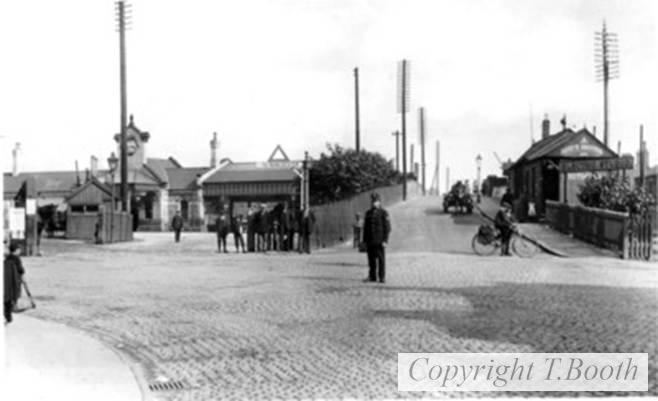
The entrance to Northwich station and goods yard, seen from Station Road in the early 1920’s. The original Cheshire Midland Railway terminus and loco shed was, until 1868, over to the left, on the site of the present petrol station. The goods and coal yard closed in 1969, Tesco opening their store and petrol station on the site in 1989. The small wooden shops seen on the bridge approach included (at various times); ‘Reece Brooks, Electric (photographic) studio’, Jack Gee cycles, a barbers shop, and a confectioners. Widening of the narrow bridge was discussed in 1925 but the idea was dropped on cost grounds. The shops were all swept away when the Middlewich Road (Station Bridge) was eventually widened in 1967. T. Booth collection.
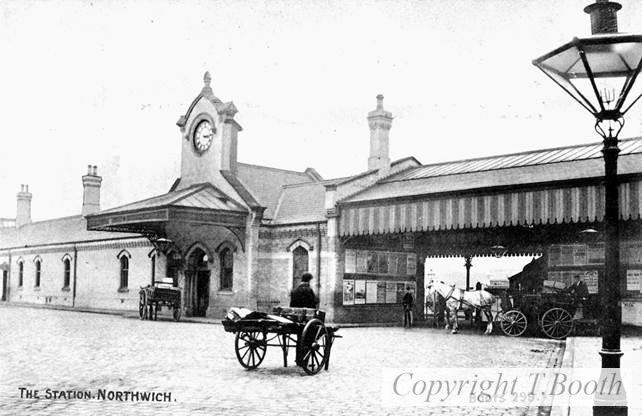
The Northwich station buildings c1905. The present station buildings and platform canopy date from the station’s rebuilding in 1897, at a cost of £8,800 (just under £1,000,000 today). The painted stripes on the wooden valancing of the cab stand canopy were a common feature of CLC stations at this time, the colours being oak brown, and buff. The splendid gas lamp was a pattern usually seen at the larger CLC stations. The clock tower, which was originally illuminated by gas, was removed in 1967. T. Booth collection.

Northwich station island platform shelter. 26th of September 1966. Passengers using the Chester/Middlewich island platform had a raw deal when it came to waiting facilities, especially when compared to what was available in the main station buildings. The shelter, with its 12 columns (and little else!), dates from at least 1875, when it was shown on the 1 to 500 Ordnance Survey map. Complaints regarding the inadequate waiting conditions were noted in 1907 when local traders asked the Northwich Urban District Council (NUDC) to take the matter up with the Cheshire Lines Committee (CLC). Despite some assurances from the CLC Manager little was done, the Committee citing the refusal of the London & North Western Railway (LNWR), whose passenger trains from Crewe used the far platform, to contribute to any improvement work. The NUDC even went as far as sending a deputation to a CLC board meeting at London Kings Cross in 1908 but to no avail. The complaints persisted but the shelter was only replaced (with ‘bus shelter’ accommodation) sixty years later in 1967. With the wind in the wrong direction, waiting for your train on a cold wet day, next to a busy steam loco shed can’t have been pleasant. The new re-sited shelter in 1967, together with the end of steam locomotive working in 1968 was an improvement but unfortunately not by much! T.Booth collection.
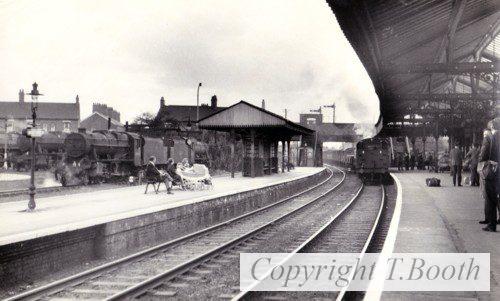
Northwich station 1966. Several passengers look on as a freight train from Winnington passes through the station heading for the Northwich marshalling yard. Even by this date thanks to the Imperial Chemical Industries, rail traffic here never really stopped, running 24 hours a day, 7 days a week. These were the days when passenger trains still had large guard’s compartments that could accommodate huge babies’ prams. Manchester Locomotive society.
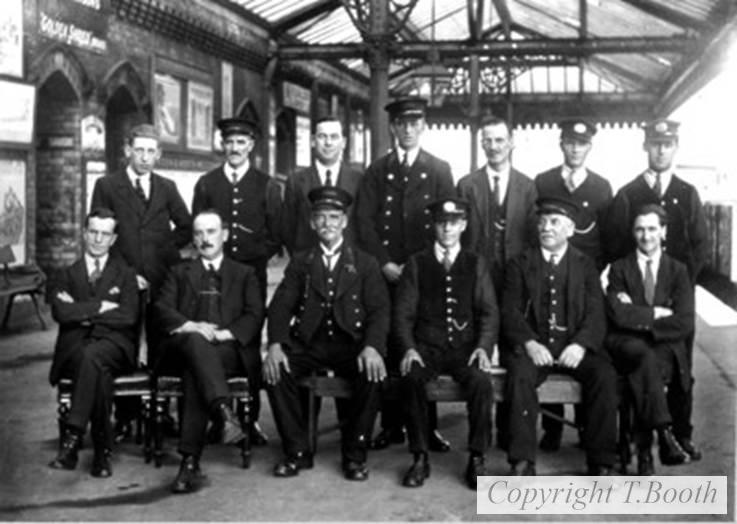
Some of the Northwich station staff c1920. Back row (L to R); Eric Billington (clerk), Arthur Hambleton, Walter Barker, Tommy Woodier (Ticket collector), George Ward, George Hancock, Jack Morgan. Front row (L to R); Jack Cross, Mr. A. Wyatt (station master), Jock Kinsey (passenger guard), Jack Sandbach, Bill Whitland (station foreman), Billy Woods (W.H.Smith bookstall). Mr. Wyatt had come to Northwich station in 1919 and in 1922 was promoted to station master at Stockport. T. Booth collection.
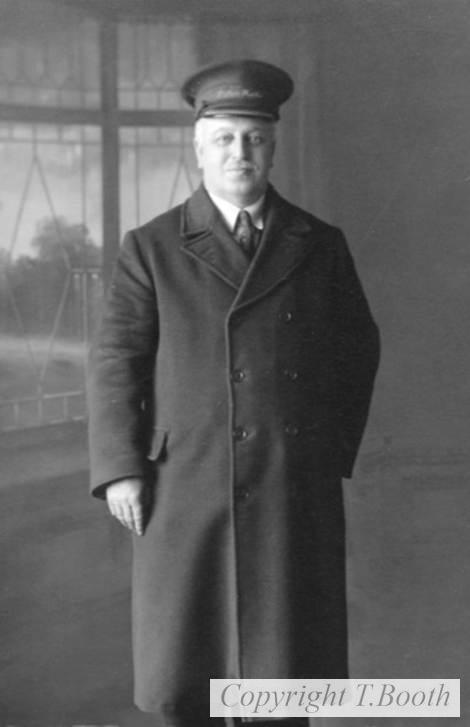
Harry Welch, Northwich, station master (1933-42). Born in the station house at Helsby & Alvanley in 1880, Harry Welch’s first station master appointment was when he succeeded his father in 1902, his father having been the station master at Helsby since 1875. In 1914 Harry Welch became station master at Lostock Gralam, leaving there in 1921 for Cuddington station. In 1927, for promotion, he took a similar position at Greenbank, and five years later was appointed to his last station master’s position at Northwich from where he retired in 1942. He was popular with passengers, where they presented him with a gold watch on his promotion from Cuddington, although he seems to have been equally liked, and disliked by members of the staff under him. One old Northwich railwayman describing him as being ‘…a pompous little man’. T.Booth collection.

Northwich station c1910. Parked outside the entrance to the station booking hall is a taxi belonging to ‘Isaac Robinson and Sons, 44 Station Road Northwich’. On the 3rd of August 1909 Robinsons had been granted a licence for two taxi-cabs to ply for hire within the Northwich Urban District Council area. Only the wealthy could afford to pay for such luxuries, although the inconveniently sited station no doubt ensured a steady flow of customers. Does anyone know the make of the vehicle? T. Booth collection.

Manchester Road level crossing. On the morning of the 5th of November 1908 Mrs Abigale Le Neve Foster of Wilmslow was travelling along Manchester Road, heading for Chester in her chauffer driven Napier car, when it collided with a train emerging from Northwich goods yard which was heading for the sidings at Barons Quay. Mrs Le Neve Foster was killed instantly; the chauffer was trapped beneath the car for a while but survived, along with Mrs Le Neve Fosters pet dog. It was possibly the first fatal accident, in Britain at least, between a train and a motor car. One eyewitness remembered a local taxi operator, not wishing to waste the opportunity, salvaging some parts off the wrecked car! In the picture, taken on Manchester Road opposite where the exit from the filling station now is, a crowd of railway officials and morbid bystanders examine the remains of the Napier car. The yard wall and outbuildings of the Locomotive Inn are on the left, in the middle is the siding into Clegghorn & Wilkinson (Engineers and Boilermakers), and to the right is the line down to Barons Quay. A set of level crossing gates were installed here the following year. The branch line to Barons Quay was closed in September 1955. The Locomotive Inn closed in 1974, and has since been converted into flats. T. Booth collection.
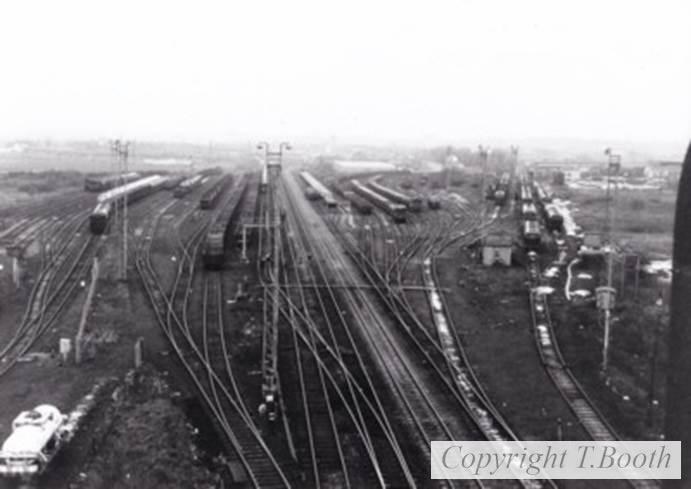
Northwich marshalling yards, 1980. Viewed from the top of a lighting tower near Lostock Works, this shows well the scale of the siding accommodation at Northwich. From its opening in 1863 extra sidings for receiving, sorting, and despatching goods trains had to added.
During the First World War the demands put on the CLC, serving as it did the vast Brunner Mond factories, meant more sidings were needed.
During the Second World War traffic was even greater, which was met with yet more sidings and improvements, all paid for by the government of course.
Remarkably despite now being able to hold 2,000 wagons this still wasn’t enough space, and the yards were regularly choked up with traffic for days on end, a situation known by local railwaymen as ‘having the block on’. At times trains couldn’t get in because there wasn’t any space to marshal trains together so they could leave in order to free up sidings for the inbound traffic. These conditions continued into the early 1950’s. Nearly all of the sidings seen here have since been removed. T. Booth collection.








